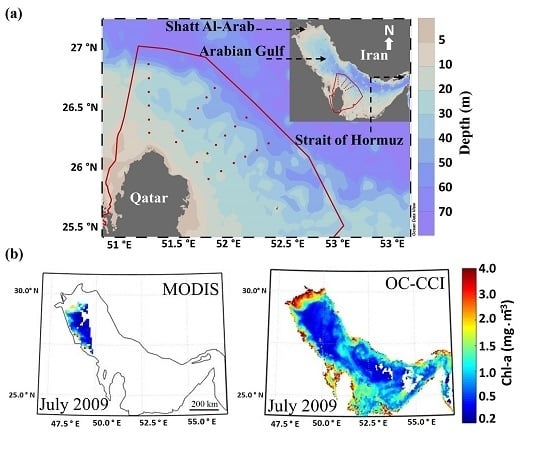Evaluation of Satellite Retrievals of Chlorophyll-a in the Arabian Gulf
Abstract
:1. Introduction
2. Methodology and Data
2.1. In Situ Data
2.2. Satellite Data
2.2.1. Chlorophyll Data
2.2.2. Calculation of the First Optical Depth
2.2.3. Comparison of Satellite-Derived Chlorophyll with In Situ Fluorescence
3. Results
3.1. Seasonal Variablity of Satellite-Derived Chloropyll
3.2. Seasonal In Situ Vertical Chl-a Profiles
3.3. Seasonal Satellite-Derived Kd
3.4. Comparison of Satellite-Derived Chlorophyll with In Situ Fluorescence
4. Discussion
5. Conclusions
Supplementary Materials
Acknowledgments
Author Contributions
Conflicts of Interest
References
- Naser, H. Marine Ecosystem Diversity in the Arabian Gulf: Threats and Conservation. In Biodiversity-The Dynamic Balance of the Planet; Grillo, O., Ed.; InTech Publishing: Rijeka, Croatia, 2014; pp. 297–328. [Google Scholar]
- Quigg, A.; Al-Ansi, M.; Al Din, N.; Wei, L.; Nunnally, C.; Al-Ansari, I.; Gilbert, T.R.; Yousria, S.; Ibrahim, A.-M.; Ismail, M.; et al. Phytoplankton along the coastal shelf of an oligotrophic hypersaline environment in a semi-enclosed marginal sea: Qatar (Arabian Gulf). Cont. Shelf Res. 2013, 60, 1–16. [Google Scholar] [CrossRef]
- Sheppard, C.R.C. Physical environment of the Gulf relevant to marine pollution: An overview. Mar. Pollut. Bull. 1993, 27. [Google Scholar] [CrossRef]
- Brook, M.; Al Shoukri, S.; Amer, K.; Boe, B.; Krupp, F. Physical and Environmental Setting of the Arabian Peninsula and Surrounding Seas. In Policy Perspectives for Ecosystem and Water Management in the Arabian Peninsula; Amer, K., Boer, B., Brook, M., Adeel, Z., Clusener-Godt, M., Saleh, W., Eds.; UNESCO and United Nations University International Network on Water, Environment and Health: Hamilton, ON, Canada, 2006; pp. 1–16. [Google Scholar]
- Naser, H. Human impacts on marine biodiversity: Macrobenthos in Bahrain, Arabian Gulf. In The Importance of Biological Interactions in the Study of Biodiversity; Lopez-Pujol, J., Ed.; InTech Publishing: Rijeka, Croatia, 2011; pp. 109–126. [Google Scholar]
- Abdel-Jabbar, N.; Baptista, A.; Karna, T.; Turner, P.; Sen, G. US Experience Will Advance Gulf Ecosystem Research. In Geo-Informatics in Resource Management and Sustainable Ecosystem; Springer: Berlin/Heidelberg, Germany, 2013; pp. 125–140. [Google Scholar]
- Khan, N.; Munawar, M.; Price, A. The Gulf Ecosystem: Health and Sustainability; Backhuys: Leiden, The Netherlands, 2002. [Google Scholar]
- Al Kaabi, M.R.; Zhao, J.; Ghedira, H. MODIS-based mapping of Secchi disk depth using a qualitative algorithm in the shallow Arabian Gulf. Remote Sens. 2016, 8. [Google Scholar] [CrossRef]
- Halpern, B.; Walbridge, S.; Selkoe, K.; Kappel, C.; Micheli, F.; D’Agrosa, C.; Bruno, J.; Casey, K.; Ebert, C.; Fox, H.; et al. A global map of human im-pact on marine ecosystems. Science 2008, 319, 948–952. [Google Scholar] [CrossRef] [PubMed]
- Sheppard, C.; Al-Husiani, M.; Al-Jamali, F.; Al-Yamani, F.; Baldwin, R.; Bishop, J.; Benzoni, F.; Dutrieux, E.; Dulvy, N.; Durvasula, S.; et al. The Gulf: A young sea in decline. Mar. Pollut. Bull. 2010, 60, 13–38. [Google Scholar] [CrossRef] [PubMed]
- Boyer, J.; Kelble, C.; Ortner, P.; Rudnick, D. Phytoplankton bloom status: Chlorophyll a biomass as an indicator of water quality condition in the southern estuaries of Florida, USA. Ecol. Indic. 2009, 9, s56–s67. [Google Scholar] [CrossRef]
- Hattab, T.; Jamet, C.; Sammari, C.; Lahbib, S. Validation of chlorophyll-α concentration maps from Aqua MODIS over the Gulf of Gabes (Tunisia): Comparison between MedOC3 and OC3M bio-optical algorithms. Int. J. Remote Sens. 2013, 34, 7163–7177. [Google Scholar] [CrossRef]
- McClain, C.A. Decade of Satellite Ocean Colour Observations. Annu. Rev. Mar. Sci. 2009, 1, 19–42. [Google Scholar] [CrossRef] [PubMed]
- Patissier, D.B.; Gower, J.; Dekker, A.; Phinn, S.; Brando, V. A review of ocean colour remote sensing methods and statistical techniques for the detection, mapping and analysis of phytoplankton blooms in coastal and open oceans. Prog. Oceanogr. 2014, 123, 123–144. [Google Scholar] [CrossRef] [Green Version]
- Sathyendranath, S.; Brewin, R.J.W.; Brockmann, C.; Brotas, V.; Ciavatta, S.; Chuprin, A.; Couto, A.B.; Doerffer, R.; Dowell, M.; Grant, M.; et al. Creating an ocean-colour time series for use in climate studies: The experience of the ocean-colour climate change initiative. Remote Sens. Environ. 2016. under review. [Google Scholar]
- Nezlin, N.; Polikarpov, I.; Al-Yamani, F. Satellite-measured chlorophyll distribution in the Arabian Gulf: Spatial, seasonal and inter-annual variability. Int. J. Oceans Oceanogr. 2007, 2, 139–156. [Google Scholar]
- Nezlin, N.; Polikarpov, I.; Al-Yamani, F.; Subba Rao, D.; Ignatov, A. Satellite monitoring of climatic factors regulating phytoplankton variability in the Arabian (Persian) Gulf. J. Mar. Syst. 2010, 82, 47–60. [Google Scholar] [CrossRef]
- Shehhi, M.; Gherboudj, I.; Ghedira, H. An overview of historical harmful algae blooms outbreaks in the Arabian Seas. Mar. Pollut. Bull. 2014, 86, 314–324. [Google Scholar] [CrossRef] [PubMed]
- Zhao, J.; Ghedira, H. Monitoring red tide with satellite imagery and numerical models: A case study in the Arabian Gulf. Mar. Pollut. Bull. 2014, 79, 305–313. [Google Scholar] [CrossRef] [PubMed]
- IOCCG (International Ocean-Colour Coordinating Group). Remote Sensing of Ocean Colour in Coastal, and Other Optically-Complex Waters; Sathyendranath, S., Ed.; Report of the International Ocean-Colour Coordinating Group, No. 3; International Ocean-Colour Coordinating Group: Dartmouth, NS, Canada, 2000. [Google Scholar]
- Lavender, S.; Jackson, T.; Sathyendranath, S. The Ocean Colour Climate Change Initiative: Merging ocean colour observations seamlessly. Ocean Chall. 2015, 21, 29–31. [Google Scholar]
- Racault, M.-F.; Sathyendranath, S.; Platt, T. Impact of missing data on the estimation of ecological indicators from satellite ocean-colour time-series. Remote Sens. Environ. 2014, 152, 15–28. [Google Scholar] [CrossRef]
- Brewin, R.J.W.; Sathyendranath, S.; Müller, D.; Brockmann, C.; Deschamps, P.Y.; Devred, E.; White, G.N. The Ocean Colour Climate Change Initiative: III. A round-robin comparison on in-water bio-optical algorithms. Remote Sens. Environ. 2015, 162, 271–294. [Google Scholar] [CrossRef]
- Brewin, R.J.W.; Raitsos, D.E.; Dall’Olmo, G.; Zarokanellos, N.; Jackson, T.; Racault, M.F.; Hoteit, I. Regional ocean-colour chlorophyll algorithms for the Red Sea. Remote Sens. Environ. 2015, 165, 64–85. [Google Scholar] [CrossRef]
- OceanColour—CCI. Available online: https://www.oceancolour.org/ (accessed on 18 February 2016).
- ESA CCI Ocean Colour website. Available online: http://www.esa-oceancolour-cci.org/ (accessed on 20 September 2016).
- Oceancolor Data. Available online: https://oceandata.sci.gsfc.nasa.gov/ (accessed on 4 October 2016).
- Steinmetz, F.; Deschamps, P.; Ramon, D. Atmospheric correction in presence of sun glint: Application to MERIS. Opt. Express 2011, 19, 571–587. [Google Scholar] [CrossRef] [PubMed]
- Racault, M.F.; Raitsos, D.E.; Berumen, M.L.; Brewin, R.J.W.; Platt, T.; Sathyendranath, S.; Hoteit, I. Phytoplankton phenology indices in coral reef ecosystems: Application to ocean-colour observations in the Red Sea. Remote Sens. Environ. 2015, 160. [Google Scholar] [CrossRef]
- Grant, M.; Jackson, T.; Chuprin, A.; Sathyendranath, S.; Zühlke, M.; Storm, T.; Groom, S. Ocean Colour Climate Change Initiative (OC-CCI)—Phase Two. Product User Guide. 2015. Available Online: ftp://ftp.rsg.pml.ac.uk/occci-v2.0/documentation/OC-CCI-PUG-v2.0.5.pdf (accessed on 28 September 2016).
- Qiu, Z.; Wu, T.; Su, Y. Retrieval of diffuse attenuation coefficient in the China seas from surface reflectance. Opt. Express 2013, 21. [Google Scholar] [CrossRef] [PubMed]
- Lee, Z.-P.; Darecki, M.; Carder, K.L.; Davis, C.O.; Stramski, D.; Rhea, W.J. Diffuse attenuation coefficient of downwelling irradiance: An evaluation of remote sensing methods. J. Geophys. Res. Oceans 2005, 110. [Google Scholar] [CrossRef]
- Bailey, S.; Werdell, P.A. multi-sensor approach for the on-orbit validation of ocean colour satellite data products. Remote Sens. Environ. 2006, 102. [Google Scholar] [CrossRef]
- Wattelez, G.; Dupouy, C.; Mangeas, M.; Lefèvre, J.; Frouin, R. A Statistical algorithm for estimating chlorophyll concentration in the New Caledonian lagoon. Remote Sens. 2016, 8. [Google Scholar] [CrossRef] [Green Version]
- Zhang, C.; Hu, C.; Shang, S.; Müller-Karger, F.E.; Li, Y.; Dai, M.; Hong, H. Bridging between SeaWiFS and MODIS for continuity of chlorophyll-a concentration assessments off Southeastern China. Remote Sens. Environ. 2006, 102. [Google Scholar] [CrossRef]
- Marrari, M.; Hu, C.; Daly, K. Validation of SeaWiFS chlorophyll a concentrations in the Southern Ocean: A revisit. Remote Sens. Environ. 2006, 105. [Google Scholar] [CrossRef]
- Campbell, J.W. The lognormal distribution as a model for bio-optical variability in the sea. J. Geophys. Res. 1995, 100, 13237–13254. [Google Scholar] [CrossRef]
- O’Reilly, J.E. SeaWiFS Postlaunch Calibration and Validation Analyse, Part 3; Hooker, S.B., Firestone, E.R., Eds.; NASA Tech. Memo. 2000-206892; NASA Goddard Space Flight Center: Greenbelt, MD, USA, 2000; Volume 11, p. 49.
- Doney, S.C. Plankton in a warmer world. Nature 2006, 444, 695–696. [Google Scholar] [CrossRef] [PubMed]
- Moradi, M.; Kabiri, K. Spatio-temporal variability of SST and Chlorophyll-a from MODIS data in the Persian Gulf. Mar. Pollut. Bull. 2015, 98. [Google Scholar] [CrossRef] [PubMed]
- Morel, A.; Huot, Y.; Gentili, B.; Werdell, P.J.; Hooker, S.B.; Franz, B.A. Examining the consistency of products derived from various ocean colour sensors in open ocean (Case 1) waters in the perspective of a multi-sensor approach. Remote Sens. Environ. 2007, 111. [Google Scholar] [CrossRef]
- Perrone, T.J. Winter Shamal in the Persian Gulf, Naval Environmental Prediction Research Facility; Technical Report, 79-06; Naval Environmental Prediction Research Facility: Monterey, CA, USA, 1979; p. 180. [Google Scholar]
- Reynolds, R. Physical Oceanography of the Persian Gulf, Strait of Hormuz, and the Gulf of Oman—Results from the Mt. Mitchell Expedition. Mar. Pollut. Bull. 1993, 27, 35–59. [Google Scholar] [CrossRef]
- Raitsos, D.E.; Pradhan, Y.; Hoteit, I.; Brewin, R.J.W.; Stenchikov, G. Remote sensing the phytoplankton seasonal succession of the Red Sea. PLoS ONE 2013, 8. [Google Scholar] [CrossRef] [PubMed]
- Shang, S.L.; Dong, Q.; Hu, C.M.; Lin, G.; Li, Y.H.; Shang, S.P. On the consistency of MODIS chlorophyll $a$ products in the northern South China Sea. Biogeosciences 2014, 11. [Google Scholar] [CrossRef]
- Tilstone, G.H.; Lotliker, A.A.; Miller, P.I.; Ashraf, P.M.; Kumar, T.S.; Suresh, T.; Menon, H.B. Assessment of MODIS-Aqua chlorophyll-a algorithms in coastal and shelf waters of the eastern Arabian Sea. Cont. Shelf Res. 2013, 65. [Google Scholar] [CrossRef]
- Brewin, R.J.W.; Raitsos, D.E.; Pradhan, Y.; Hoteit, I. Comparison of chlorophyll in the Red Sea derived from MODIS-Aqua and in vivo fluorescence. Remote Sens. Environ. 2013, 136, 218–224. [Google Scholar] [CrossRef]
- Kahru, M.; Kudela, R.M.; Anderson, C.R.; Manzano-Sarabia, M.; Mitchell, B.G. Evaluation of satellite retrievals of ocean chlorophyll-a in the California current. Remote Sens. 2014, 6, 8524–8540. [Google Scholar] [CrossRef]

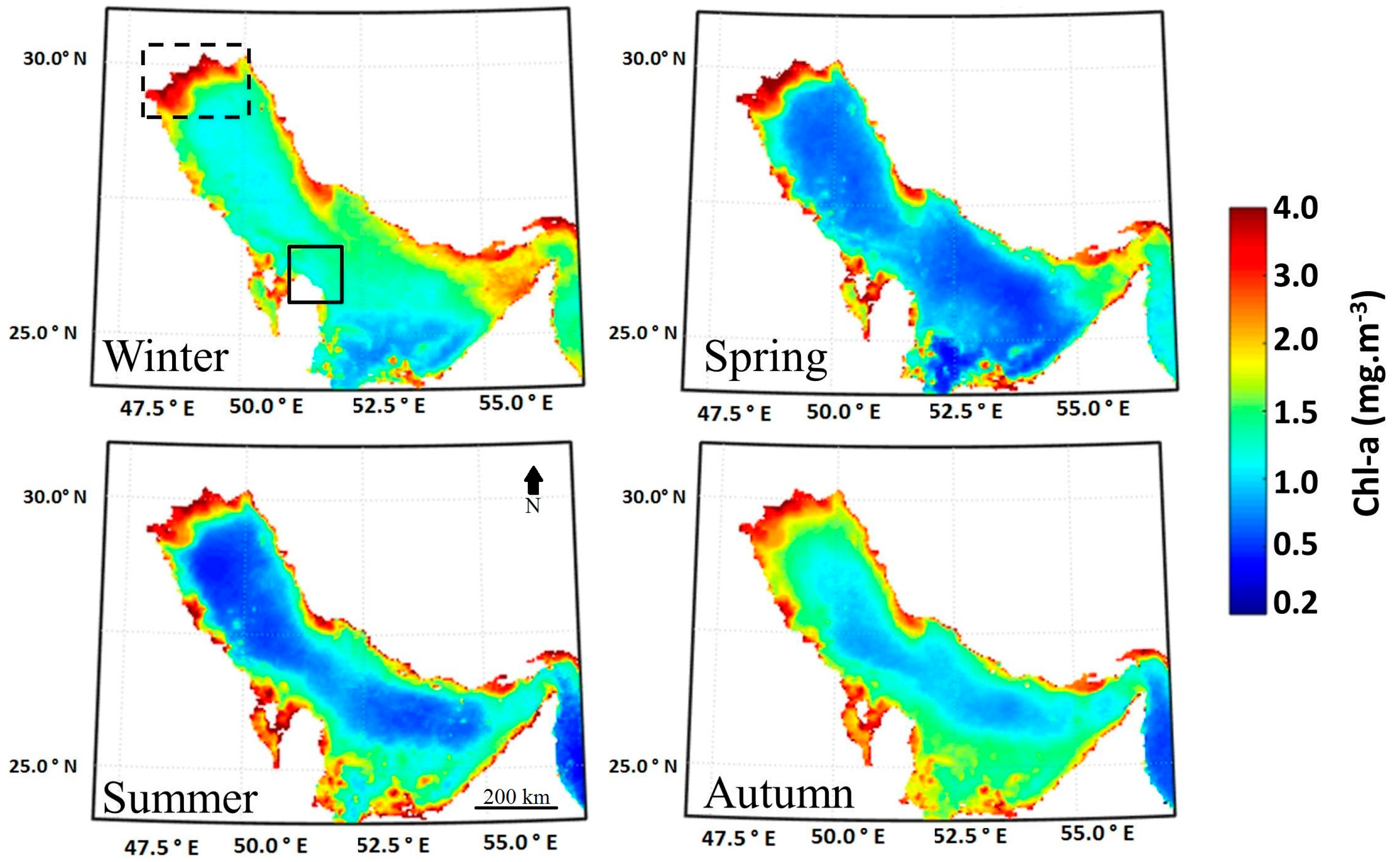
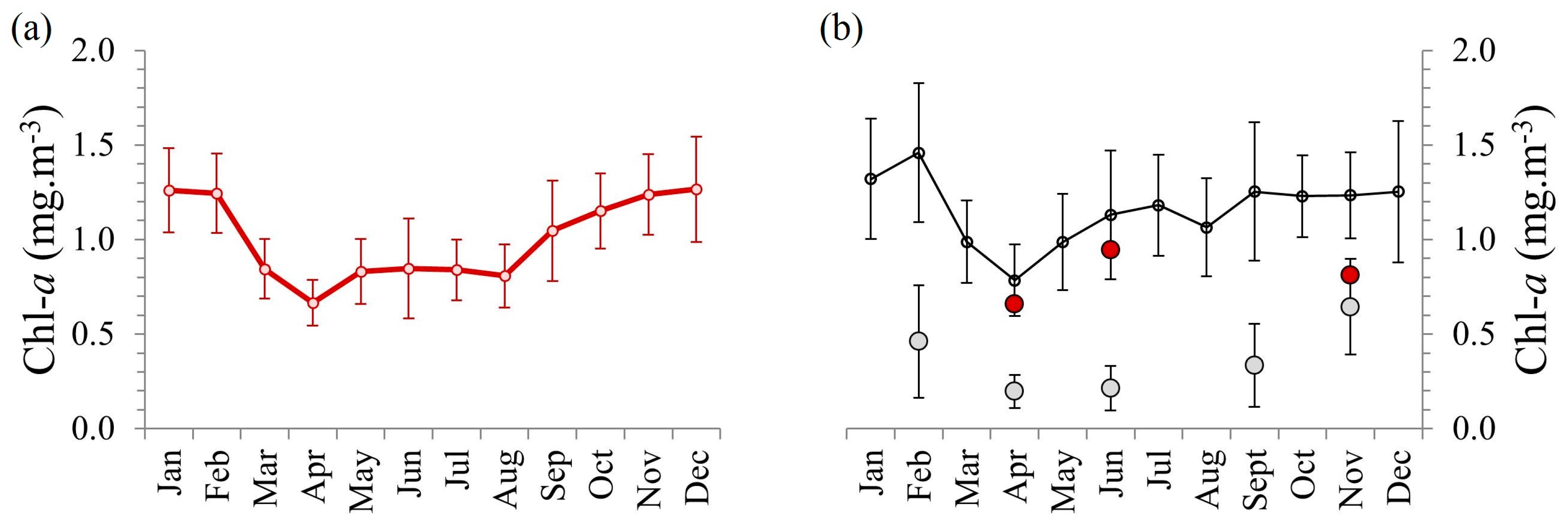
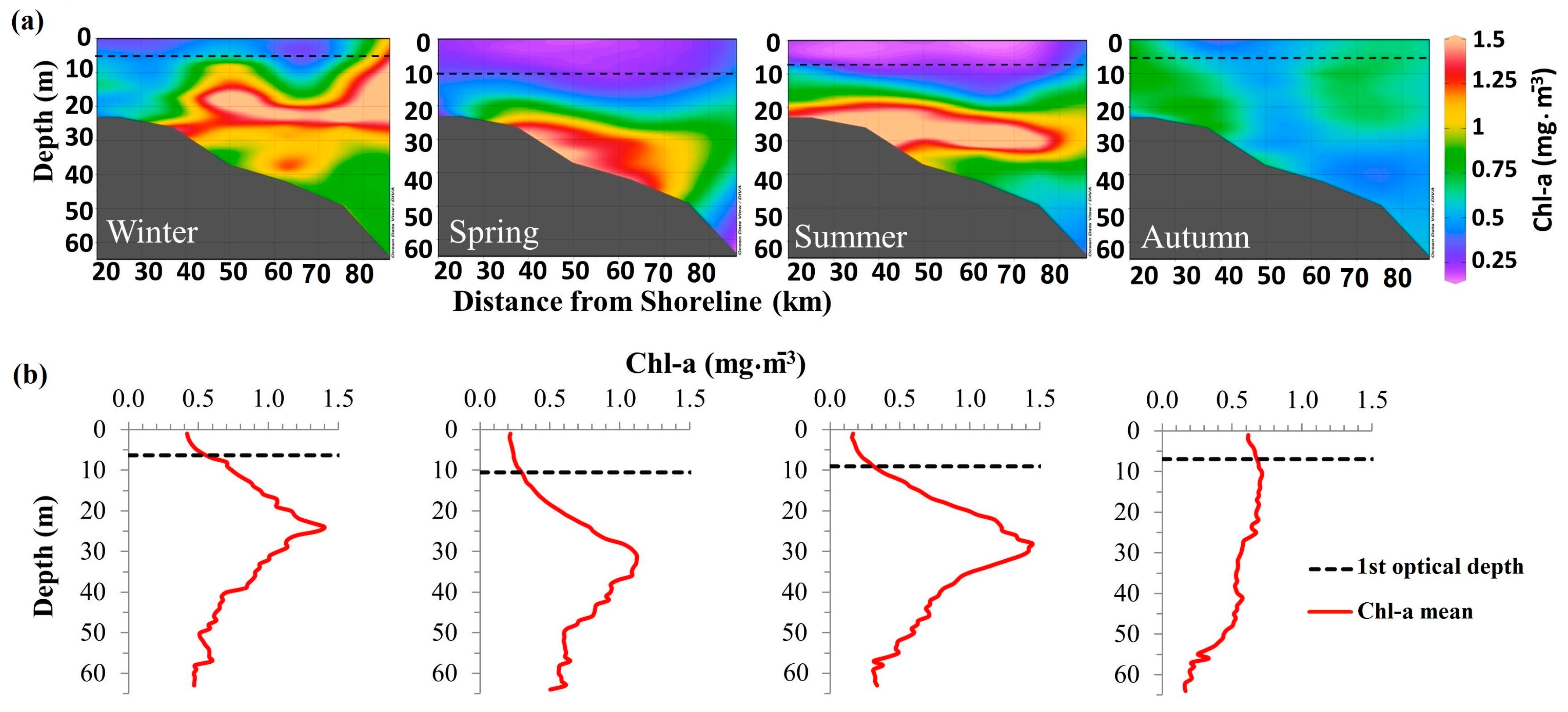
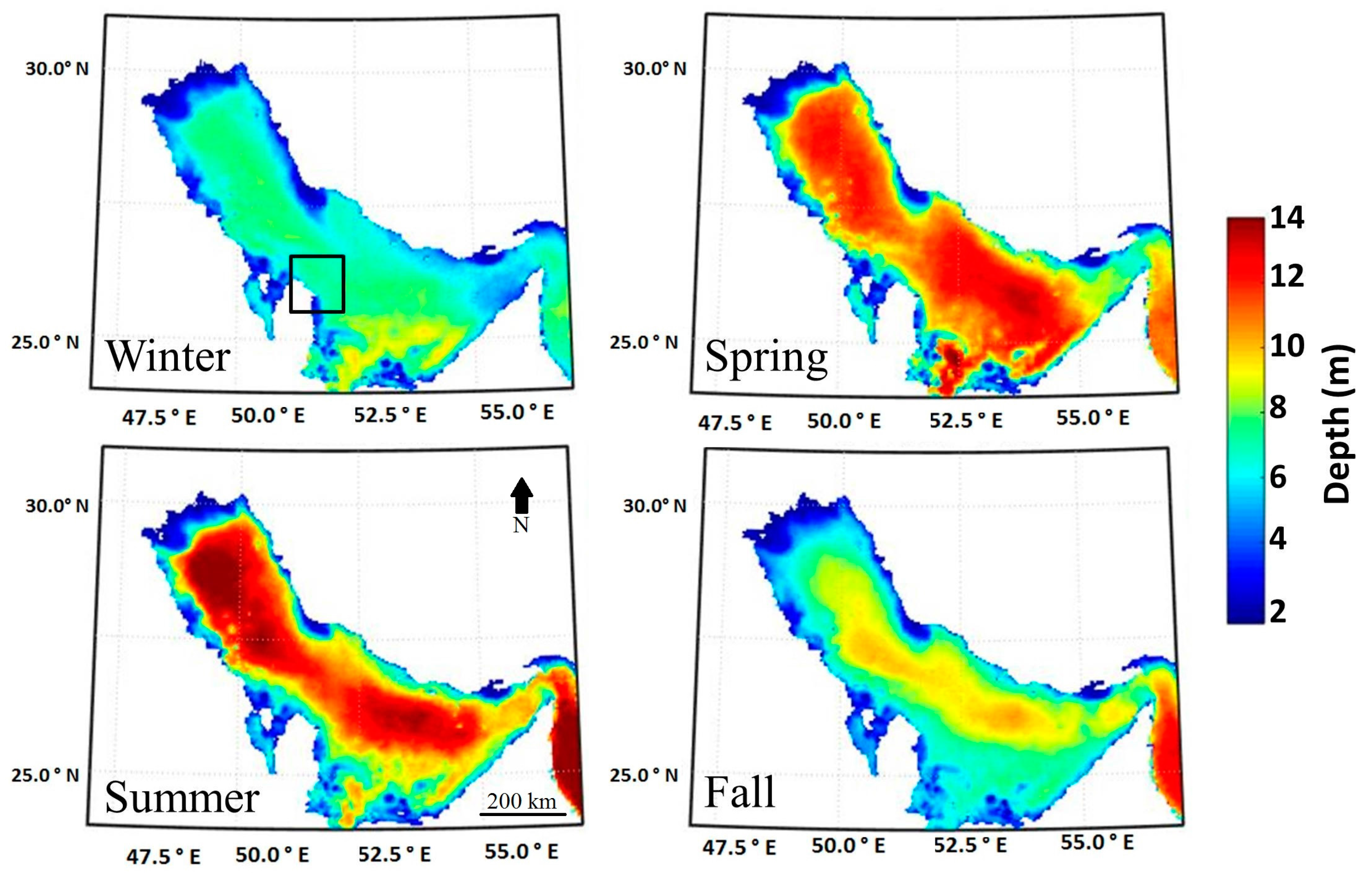
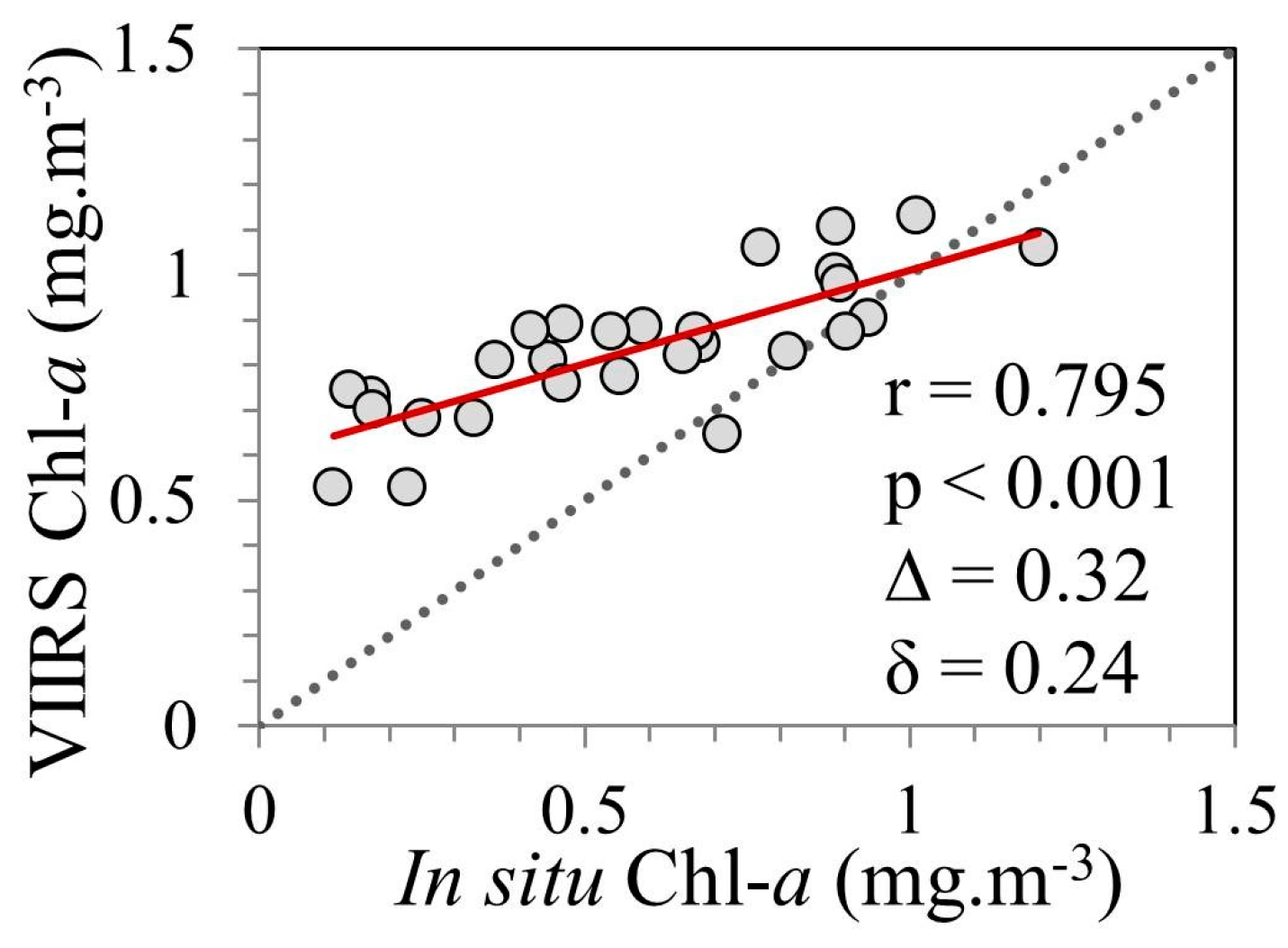
| Region | Sensor | Algorithm | Log_RMS | N | Study |
|---|---|---|---|---|---|
| Gulf of Gabes | MODIS-Aqua | OC3M | 0.64 | 30 | Hattab et al. (2013) [12] |
| Northern South China Sea | MODIS-Aqua | OC3M | 0.38 | 114 | Shang et al. (2014) [45] |
| Eastern Arabian Sea | MODIS-Aqua | OC3M | 0.31 | 50 | Tilstone et al. (2013) [46] |
| Red Sea | MODIS-Aqua | OC3 | 0.18 | 85 | Brewin et al. (2013) [47] |
| California Current Bed | VIIRS | OC3 | 0.23 | 38 | Kahru et al. (2014) [48] |
| Central Arabian Gulf | VIIRS | OC3 | 0.32 | 29 | This study |
© 2017 by the authors. Licensee MDPI, Basel, Switzerland. This article is an open access article distributed under the terms and conditions of the Creative Commons Attribution (CC BY) license ( http://creativecommons.org/licenses/by/4.0/).
Share and Cite
Al-Naimi, N.; Raitsos, D.E.; Ben-Hamadou, R.; Soliman, Y. Evaluation of Satellite Retrievals of Chlorophyll-a in the Arabian Gulf. Remote Sens. 2017, 9, 301. https://doi.org/10.3390/rs9030301
Al-Naimi N, Raitsos DE, Ben-Hamadou R, Soliman Y. Evaluation of Satellite Retrievals of Chlorophyll-a in the Arabian Gulf. Remote Sensing. 2017; 9(3):301. https://doi.org/10.3390/rs9030301
Chicago/Turabian StyleAl-Naimi, Noora, Dionysios E. Raitsos, Radhouan Ben-Hamadou, and Yousria Soliman. 2017. "Evaluation of Satellite Retrievals of Chlorophyll-a in the Arabian Gulf" Remote Sensing 9, no. 3: 301. https://doi.org/10.3390/rs9030301






